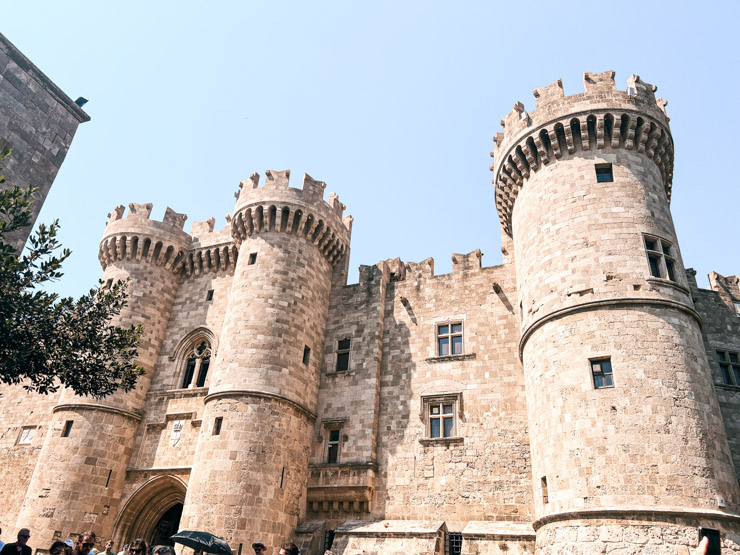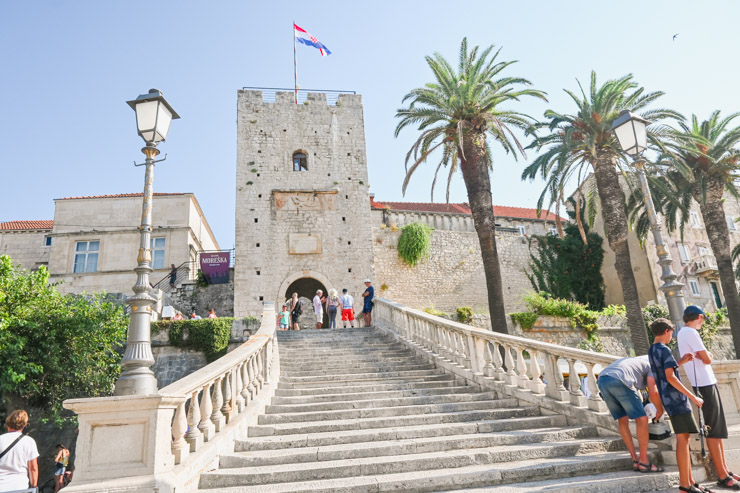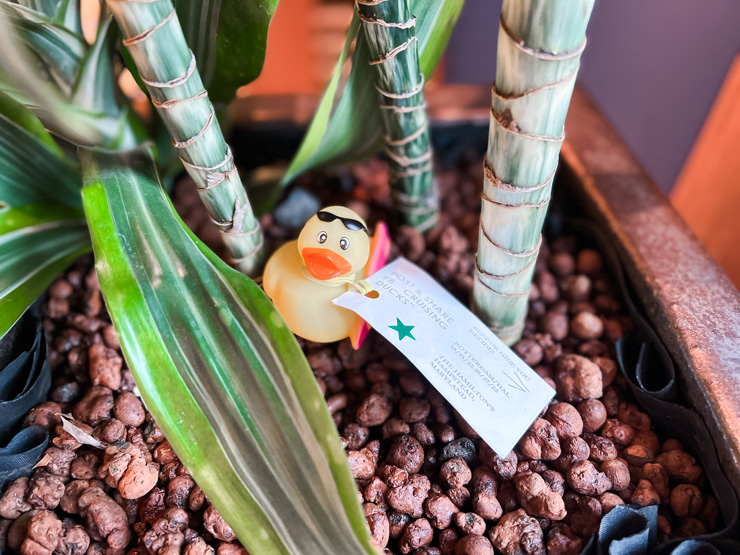Ephesus Turkey Cruise Port: Things to Do in Ephesus
As Daniel and I explored Ephesus, we felt like modern-day adventurers uncovering history and mystery. The vibrant streets and markets merged past and present, creating unforgettable experiences. Join us as we navigate Ephesus, Turkey discovering hidden treasures and the stories of emperors and gladiators. This guide will take you through the Library of Celsus and the Great Theatre, offering insights into Ephesus’ glorious past and vibrant culture. Let’s embark on this adventure where history and freedom blend seamlessly.
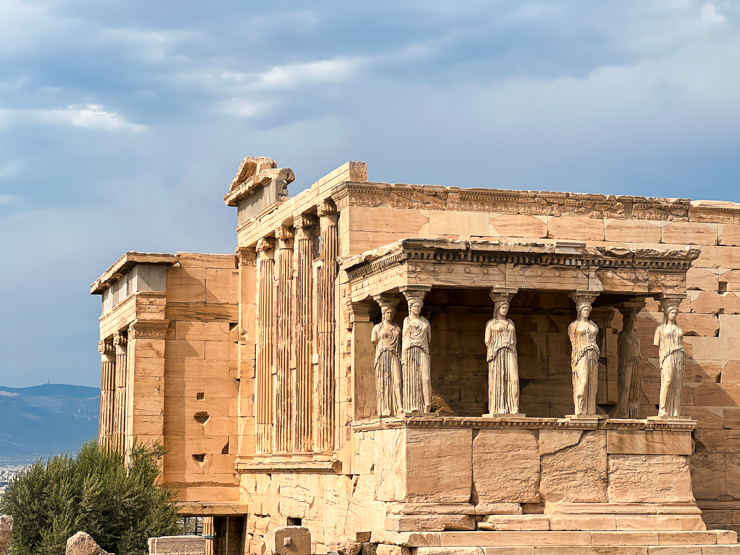
Where is Ephesus, and a Brief History?
On our Mediterranean cruise with Holland America, we discovered Ephesus as a city of historical and archaeological significance. Ephesus, originally a Greek city, was later controlled by the Roman Empire. It flourished under Roman Emperor Augustus, becoming a major trade and cultural center. We saw the Temple of Artemis, one of the Seven Wonders, and the Library of Celsus, showcasing ancient architectural marvels. St. Paul also visited, leaving a mark on the city’s history. Ephesus offers a glimpse into the past glory of this ancient metropolis.
What is the Best Time to Visit Ephesus?
During this cruise, we learned that spring and fall are ideal for visiting Ephesus. The weather is mild, and crowds are smaller. As we were there in the summer, we found it is best to visit early in the day to avoid heat and tour bus crowds. Ephesus, dating back to the 10th century BC, has witnessed events like the Ionian Revolt during the Hellenistic period.
Visiting Ephesus in spring offers blooming flowers and pleasant temperatures, enhancing the exploration of the ruins. In fall, warm weather allows a deeper dive into the Temple of Hadrian and the Terrace Houses without summer heat or large crowds. Spring and fall are ideal for exploring Ephesus, whether retracing Apostle Paul’s steps or enjoying the ancient atmosphere.
Is Ephesus Open on Sundays?
We visited Ephesus on a Sunday and found that it is indeed open to visitors on that day. Despite its ancient roots dating back to Roman rule and being one of the seven wonders of the ancient world, Ephesus welcomes guests throughout the week, including Sundays. As a significant site in the history of early Christianity, with ties to Saint John and the Basilica of St. John, it remains accessible even on weekends. The Byzantine Empire’s influence can be seen throughout the archaeological site, making it a fascinating destination for history enthusiasts.
On our visit, a knowledgeable tour guide led us through the well-preserved ruins, including the impressive Grand Theatre and the Church of the Virgin Mary. The vibrant history of Ephesus truly came to life on this special Sunday excursion. So, if you’re considering a visit to Ephesus and are worried about it being closed on Sundays, rest assured that you can explore this remarkable site any day of the week.
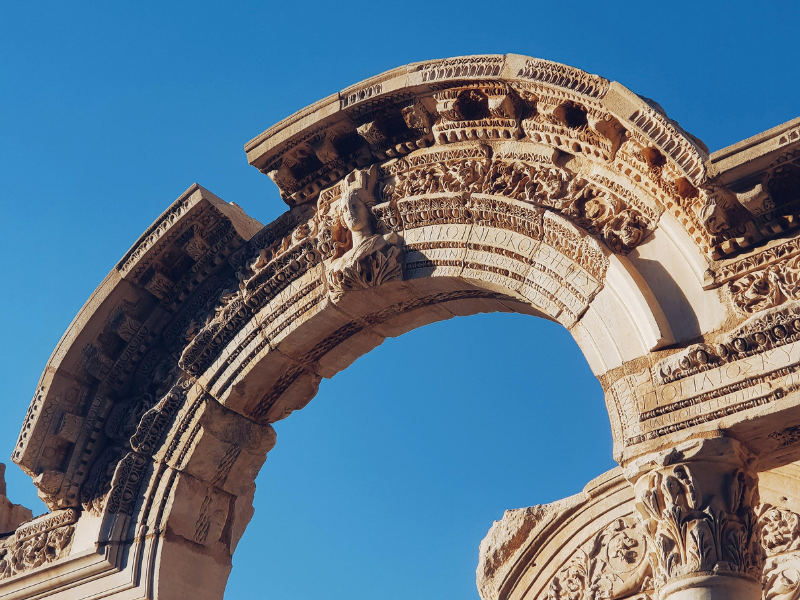
Ephesus Entrance Fee
Visitors to Ephesus must pay an entrance fee to access the archaeological site. Ephesus, located in western Turkey, was founded by Ionian Greek colonists around 1000 BC. Throughout history, Ephesus thrived under various empires, including the Romans. Travelers can explore well-preserved Roman baths, reading rooms, and pagan temples within the ancient ruins. Influential figures like Emperor Augustus and Emperor Hadrian left their mark on Ephesus. To fully appreciate its history, join a guided tour for deeper insights into this remarkable site. The entrance fee allows you to wander through ancient streets and immerse yourself in Ephesus’ rich cultural heritage. Don’t miss the chance to explore this captivating destination in person.
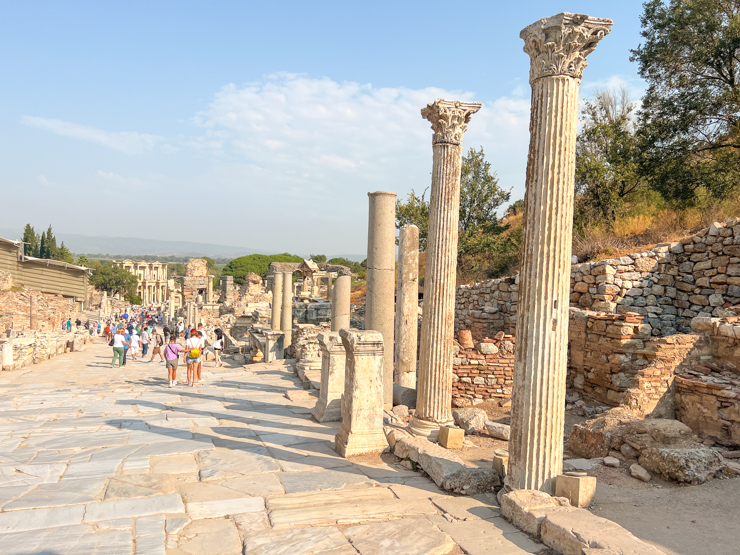
Is Ephesus Included in the Turkey Museum Pass?
Ephesus is not included in the Turkey Museum Pass. The pass grants access to many museums and archaeological sites across Turkey, like Topkapi Palace and Hagia Sophia in Istanbul, but not Ephesus. This ancient city, once a Roman Empire hub, was also a capital of Asia Minor during the Ottoman Empire and a key site for early Christianity. The well-preserved Ephesus ruins, including the Library of Celsus and the Temple of Artemis, attract visitors from around the globe.
Despite not being part of the Turkey Museum Pass, visiting Ephesus is highly recommended. As a UNESCO World Heritage Site, the ancient ruins offer a glimpse into the past, showcasing architectural and cultural influences from various civilizations that thrived in this significant place.
How Much Does it Cost to Enter the Terrace Houses in Ephesus?
The entrance fee for the Terrace Houses in Ephesus is $15. Visiting these ancient houses gives a fascinating glimpse into the lives of the wealthy Romans who once inhabited this area. As we wandered through the well-preserved rooms and marvelled at the intricate mosaics and frescoes, I know I couldn’t help but feel connected to the past. The Terrace Houses date back to the 1st century AD. Under ten homes have been excavated at this time since the 1960s.
Located on the Aegean coast, Ephesus boasts a rich history, with notable landmarks such as the Celsus Library and the Ephesus Museum. Exploring the Terrace Houses was like stepping back in time and witnessing firsthand the opulence of the Roman elite.
For those interested in biblical history, Ephesus is also significant as it is believed that the Apostle John and Saint Paul visited this city. The biblical Book of Ephesians is said to have been written to the Christian community in Ephesus.
How Much Time Do You Need in Ephesus?
We spent a full day exploring Ephesus and truly enjoyed its historical treasures. Ephesus, located in Asia Minor, was once an important port city in the eastern Mediterranean. Walking through its ancient ruins, I could envision the daily life of its inhabitants and the grandeur it once held. For a first-time visitor, allocating a full day was ideal to soak in the rich history and marvel at the well-preserved remnants of this former small town.
When deciding how much time you need in Ephesus, consider visiting the House of the Virgin Mary, a pilgrimage site believed to be the final dwelling of the mother of Jesus. The Terrace Houses, showcasing the luxurious lifestyle of the elite, are also worth exploring. Don’t miss the Library of Celsus, one of the best places to visit in Ephesus, and the Church of Mary, one of the seven churches of Asia mentioned in the Bible. To truly immerse yourself in the essence of Ephesus, a day allows you to grasp the significance of this ancient city.
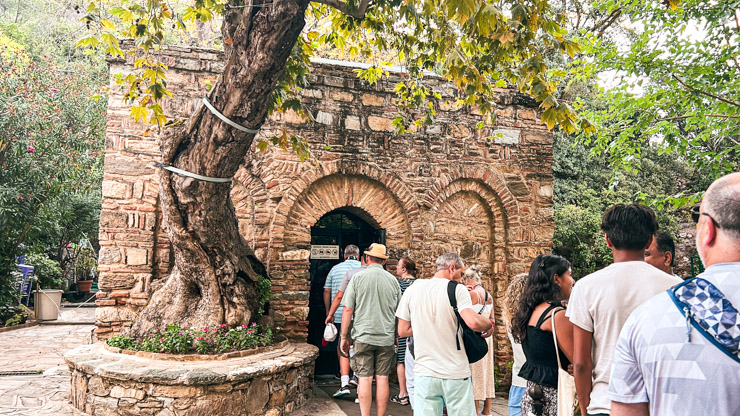

The tranquility and serenity that envelops this place are simply awe-inspiring. The house itself was re-built upon the original foundation of her house to show what it must have looked like. After touring the house, you walk down and wash your hands in Holy water and then head to the prayer wall to pray and reflect. It’s a humbling experience to witness people from all walks of life come together to pray and reflect at this holy site. The Wall of Prayer is a testament to the power of faith and unity. If you ever find yourself in Ephesus, I highly recommend making a visit to The House of the Virgin Mary. It’s a place where you can find solace, inspiration, and a renewed sense of faith.

Do you need a Guide in Ephesus?
During your visit to Ephesus, having a guide can greatly enhance your understanding of the historical significance and cultural context of the ancient city. Ephesus, located near the Aegean Sea, has a rich history that includes periods of Persian rule and being one of the cities of the Ionian League. Known for the famous Temple of Artemis, dedicated to the Greek goddess Artemis, Ephesus was a thriving city in the first century CE. The city suffered a massive earthquake in the 1st century, but it was rebuilt, and monuments like the Hadrian Temple stand as a testament to its resilience. A guide can provide insights into the cult of Artemis and the significance of the archaeological remains scattered throughout Ephesus. Navigating the ruins and understanding the stories behind them becomes more engaging with a knowledgeable guide to paint a vivid picture of Ephesus’ past.
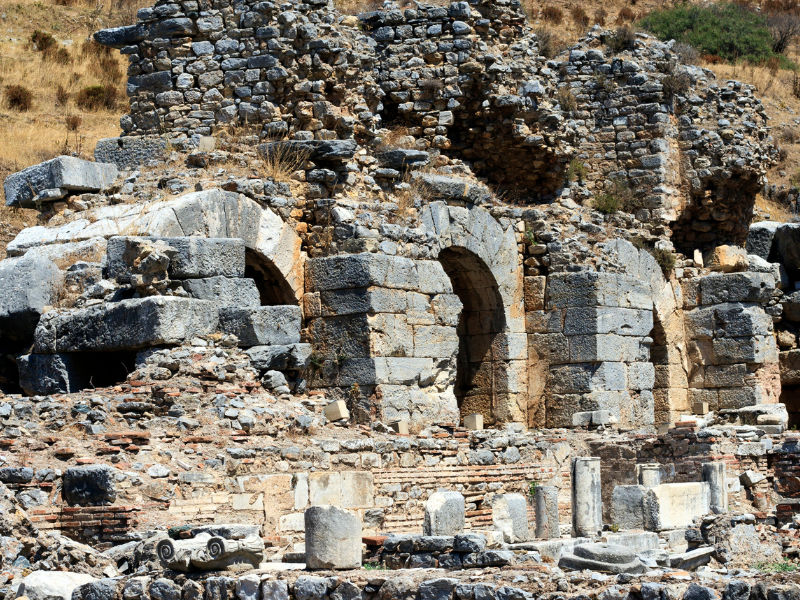
The Great Theatre
One of Ephesus’ most impressive features is the Great Theatre. Standing amidst this ancient marvel, I felt the weight of history. The Great Theatre dates back to the Hellenistic period under the Seleucid Empire. It has witnessed empires rise and fall, dramatic performances, and various events.
Located on the northern slopes of Coressus Hill, the theater seats up to 25,000 spectators. It has hosted gladiator fights and Christian church gatherings during the Third Ecumenical Council. The ornate ruins and a standing column showcase the ancient builders’ skill and craftsmanship. Walking through the aisles, I could almost hear echoes of the past, reflecting Ephesus’ rich history.
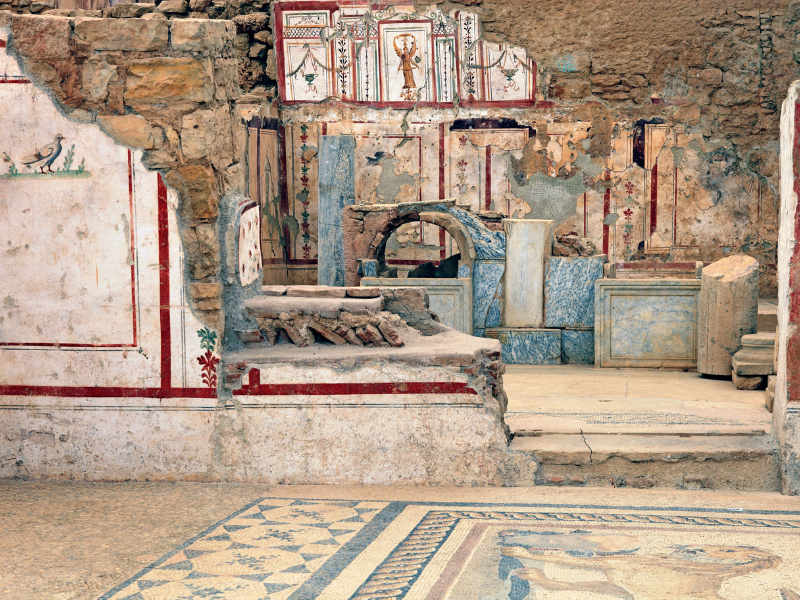
The Terrace Houses
Exploring the Terrace Houses in Ephesus reveals intricately preserved living spaces from ancient times. These houses, dating back to the 2nd century AD, have been meticulously restored in recent years, offering a glimpse into the luxurious lifestyle of Ephesian elites. The Terrace Houses are best visited in the morning when the sunlight illuminates the intricate frescoes, mosaics, and architectural details, bringing the ancient ruins to life. One of the main reasons these houses are a must-see is the level of preservation; walking through the rooms, courtyards, and hallways gives a real sense of the opulence and sophistication of the era.
What makes the Terrace Houses even more appealing is their easy access within the Ephesus archaeological site. Visitors can wander through these well-preserved structures at their own pace, exploring the intricate decorations and imagining what life was like for the wealthy inhabitants centuries ago. For history enthusiasts or those seeking a deeper connection to the past, the Terrace Houses in Ephesus offer a truly immersive experience.

The Library of Celsus
I marveled at the grandeur of the Library of Celsus in Ephesus. The intricate details of the facade and the towering columns left me in awe. Four female statues—Sofia (Wisdom), Arete (Virtue), Ennoia (Insight), and Episteme (Knowledge)—stand in niches on the library’s façade. They symbolize the virtues of Celsus and the qualities Roman officials valued. The Austrian Archaeological Institute supported the library’s restoration, and experts moved the original statues to the Ephesus Museum in Vienna.
As I stood before this ancient structure, history pressed in around me, urging me to explore its depths. Walking through the library’s remnants, you can almost hear the whispers of long-forgotten scholars. Shelves that once held over 12,000 scrolls now stand empty, reminding us how time reshapes all things. Even in its partially reconstructed state, the Library of Celsus radiates intellectual elegance and timeless sophistication. Interestingly, Celsus’ son built the library as a tribute—and a tomb—for his father, a former governor. They placed Celsus’ white marble sarcophagus in a crypt under the building, combining his memory with the library’s purpose.
We couldn’t help but imagine what it must have been like to study in such a magnificent place, surrounded by knowledge and wisdom. The Library of Celsus serves as a reminder of the importance of learning and the preservation of culture. It stands as a beacon of enlightenment in the heart of Ephesus, inviting visitors to step back in time and experience the richness of ancient Greek civilization.

Temple of Hadrian
The Temple of Hadrian in Ephesus shows stunning Roman architecture and details that capture every visitor’s attention. Hadrian was a famous Roman Emperor, known for his military success and for building Hadrian’s Wall in northern Britain. Walking through the grand entrance, you feel like you’ve stepped back in time. The detailed carvings on arches and pillars show scenes of ancient gods and Roman leaders. These designs invite visitors to explore the stories hidden in stone. Standing before the temple, you can admire the care and skill used to build it. Tall columns with intricate patterns stand proudly, showing the talent of Roman builders. The quiet courtyard, once full of life, now offers a peaceful place to pause and reflect. History and architecture lovers should not miss the Temple of Hadrian. It offers a real connection to the ancient world and its enduring legacy. This site lets you feel the presence of the past all around you. Take time to explore its beauty and discover the secrets it still holds.
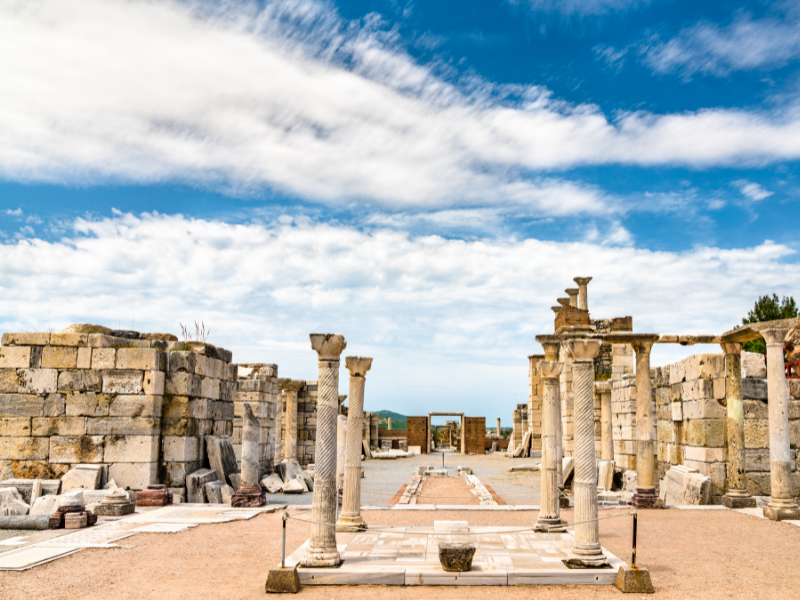
The Basilica of St. John
Emperor Justinian I built the Basilica of St. John in Ephesus during the 6th century BC. Tradition holds that St. John the Apostle and the Virgin Mary visited this site after Jesus’ death. Construction spanned nearly twenty years. The basilica once served as a pilgrimage center and housed St. John’s tomb. St. John, an apostle of Jesus, is sometimes confused with John the Baptist, who never visited Asia Minor.
The Basilica ruins feature a cross-shaped layout with six domes and St. John’s tomb. Pilgrims believed the dust from his grave had healing properties. The central nave includes the synthonon, a semicircular tiered structure behind the altar in Eastern Orthodox churches. This structure has benches for clergy, with the bishop’s throne at the center. The treasury became a chapel adorned with Byzantine mosaics. The baptistery, north of the nave, is modeled after the Jordan River.
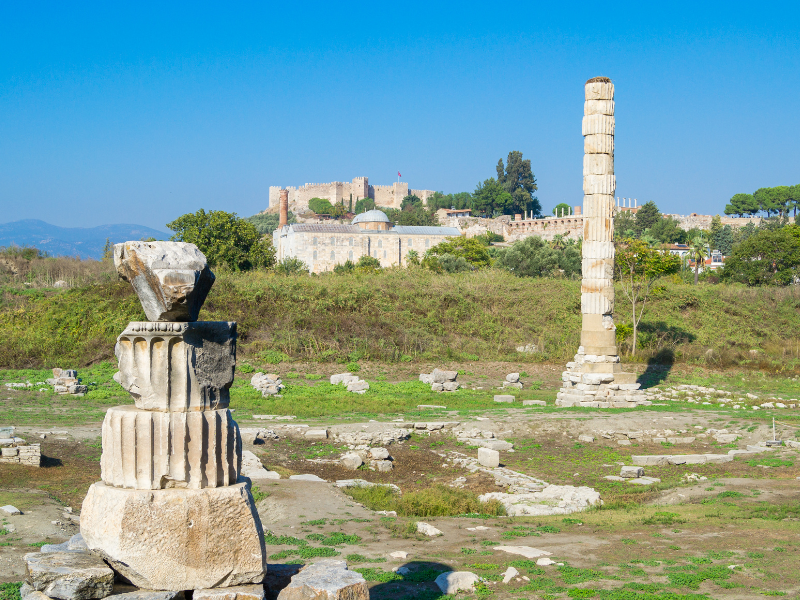
Temple of Artemis
The Temple of Artemis, built in the 6th century BC, was one of the Seven Wonders of the Ancient World. Artemis, a Greek goddess of hunting and nature, was Zeus’s daughter and Apollo’s sister. She was a patron of girls and young women and a protector during childbirth. Ephesus, with a population exceeding 250,000, was the world’s second-largest city at the time. During festivals, the city’s population would triple as people flocked to the Temple.
The Ionic temple faced damage from fires and earthquakes but was rebuilt. It survived until Late Antiquity when the Goths destroyed it. Emperor Theodosius attempted to eliminate Artemis worship by banning religious practices, closing schools and temples, and restricting women’s rights.
In the Byzantine era, Constantine the Great declared Christianity the official Roman Empire religion and established Constantinople as its Eastern capital. Ephesus declined as its port filled with silt from the Cayster River, leaving only a small lake where the harbor once was.
In the 1800s, John Turtle Wood, initially in the Ottoman Empire to design railway stations, became fascinated with Ephesus and the Temple of Artemis. His excavation uncovered the temple buried under about 20 feet of sand. Many of his finds are now in the British Museum.
Are there Restrooms at Ephesus?
You’ll find toilet facilities conveniently located throughout the archaeological site. The staff has placed them at key points for easy access. We found the restrooms clean and well-maintained, which made for a comfortable experience. They’re equipped for quick stops, so you can freshen up and continue exploring without delay. Knowing restrooms were available helped us enjoy the historical wonders of Ephesus without worry.
How Should I Dress When I Visit Ephesus?
When visiting Ephesus, dress respectfully to honor the site’s historical and religious significance. Wear modest, comfortable clothing that covers your shoulders and knees. Choose lightweight fabrics like cotton or linen for the warm Mediterranean climate. Opt for a simple t-shirt or blouse with knee-length shorts or a skirt. Bring a scarf or shawl to cover up, especially at religious sites. Wear comfortable walking shoes for uneven terrain. Protect yourself from the sun with a hat and sunscreen. Drink plenty of water, especially in summer. You can buy water near the entrance. Dressing appropriately shows respect and keeps you comfortable.
Can I Visit the Ephesus Museum?
The Ephesus Museum is not in Ephesus. It is located a short 5-10 minute drive from Ephesus in the town of Selcuk. You will see a wide range of artifacts, including jewelry, household objects, tools, statues, and other original pieces found during ongoing archaeological digs in Ephesus and the surrounding area. It also houses relics from nearby sites like the Basilica of St. John, the Temple of Artemis, and the Cukurici Mound. There is a model of the Artemis Temple that will help you imagine the original grandeur that made it an ancient wonder. Additionally, the museum features remarkable statues of the Greek goddess Artemis. If you have the time, it is definitely worth the trip.
Can I Visit Ephesus from the Kusadasi Cruise Port?
Arriving at Kusadasi Cruise Port and visiting Ephesus becomes effortless. Step off the ship and choose from various exploration options. Arrange transportation to Ephesus through a guided tour, private taxi, or local bus. Enjoy the freedom to set your own schedule without group constraints. Ephesus is just 12 miles away, about a 30-minute drive.
Once in Ephesus, explore the well-preserved streets at your own pace. Marvel at the Library of Celsus, stroll through the Grand Theater, and immerse yourself in the rich history. The proximity to Kusadasi Cruise Port allows you to maximize your time and enjoy a seamless experience. You can easily and independently visit Ephesus from the port.
Exploring Ephesus is a journey through time, filled with awe-inspiring sights and rich history. Discover grand architecture and bustling streets, each with its own story. Whether you’re passionate about history or seeking cultural adventure, Ephesus offers a captivating experience and unforgettable memories. We would advise you not to miss the chance to explore this remarkable destination.
-
Krka National Park in Croatia: Your Complete Guide
Overflowing with breathtaking waterfalls and rich history, Krka National Park in Croatia is a must-visit destination for nature enthusiasts.
-
Rhodes Ancient Greece: What to do in Rhodes
Step into the past and uncover the secrets of Rhodes Ancient Greece, where hidden treasures and untold stories await your discovery.
-
Hard Rock Hotel & Residences: Lake Texoma
Hard Rock’s debut at Lake Texoma introduces Oklahoma’s first branded residences, blending exclusive lakefront luxury with iconic Hard Rock amenities. Visitors and residents can expect world-class service, striking designs, and a unique luxury experience.
-
Santorini Cruise Port: Things to Do in Santorini
Uncover the best activities at the Santorini Cruise Port. Get ready to make the most of your time in this stunning Greek destination.
-
Korcula Cruise Port: Everything You Need to Know
Discover the hidden gems of Korcula Cruise Port! Uncover breathtaking sights, delicious cuisine, and alluring activities.
-
Volcano National Park, Big Island Hawaii
Discover the awe-inspiring wonders of Volcano National Park on the Big Island. Learn the best ways to experience this National Park.
FOLLOW US ON SOCIAL MEDIA
- Facebook Group
- Explore Oklahoma Facebook Group
- TikTok
- Hot Deals Group
- Recipe Group
- Homesteading Facebook Group
- Don’t forget to invite your friend’s to our Facebook groups! We would also love to see your vacation pictures!


